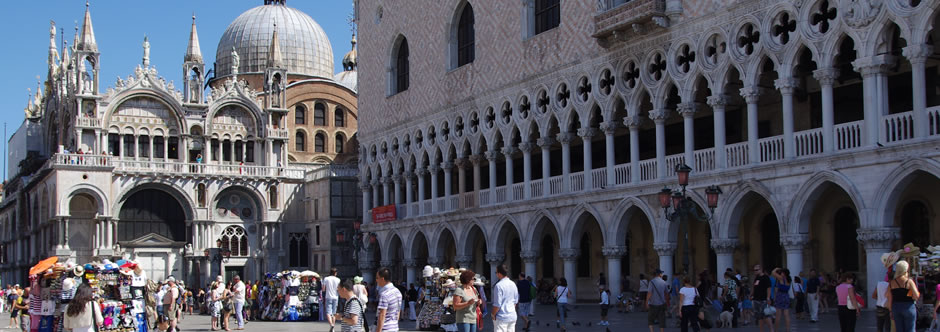
Visit Venice

This square is the central point of the city, the place all tourists arrive at at some point during their stay in Venice. The square has been a focal point of the city for centuries and is the only Venice "piazza"; the other squares are called "campi." The square has buildings on three sides and the fourth side is open to the Canal Grande. The square is a gathering place for both locals and visitors and is a pedestrian-only zone. Visitors can enjoy the open space, which is lined with pleasant outdoor cafes and restaurants and stores beneath the surrounding covered arcades. The most famous cafes on the square is the Caffe Florian. The other one is Caffe Quadri.The square is also known for the many pigeons, but it is now illegal to feed them. Venice's main street, Merceria, leads onto the square through the arch in Saint Mark's Clocktower and at the end of the square is the Grand Canal and the mooring area for Venetian gondolas.
At the opposite side of Canal Grande, you will see another island, San Giorgio Maggiore, with his famous church: San Giorgio.
The square is surrounded by some of the must-see sites of Venice like the Doge's Palace where rulers lived and ran their court; the Basilica San Marco; the basilica's free-standing campanile (bell tower); the Procuratie Nove (designed by Jacopo Sansovino) which now houses a museum; a small Loggetta next to the Campanile which was also built by Sansovino; the Library of Saint Mark's and St. Mark's Square Clocktower. The small Piazzetta di San Marco separates the palace and the library building, and here two columns stand, facing the canal, commemorating the city's patrons – Saint Mark and Saint Teodoro of Amasea. One of the column statues is of the Winged Lion of Venice.
Originally the square was the front courtyard of a small chapel (now the Basilica) and the Rio Batario ran between the square and the Doge's Palace. In 1174 the canal was filled up and the square repaved with a beautiful herringbone pattern almost 100 years later in 1267. Andrea Tirali came up with a more complex pattern for the square paving using natural Istrian stone in 1735. The square was used by traders as a convenient market place. The square is adorned with three tall flagpoles with bronze relief bases designed by Alessandro Leopardi (1505), the Italian flag flies here above the beautiful and constantly busy square.

